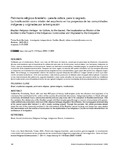Mostrar o rexistro simple do ítem
Patrimonio religioso brasileño, para la cultura, para lo sagrado: la inculturación como misión del arquitecto en los proyectos de las comunidades indígenas y originadas por la inmigración
| dc.contributor.author | Bonk Machado, Tobias | |
| dc.date.accessioned | 2020-10-05T08:33:50Z | |
| dc.date.available | 2020-10-05T08:33:50Z | |
| dc.date.issued | 2020 | |
| dc.identifier.citation | Bonk Machado, Tobias. 2020. «Patrimonio religioso brasileño - para la cultura, para lo sagrado. La inculturación como misión del arquitecto en los proyectos de las comunidades indígenas y originadas por la inmigración». Actas de Arquitectura Religiosa Contemporánea 7: 128-141. https://doi.org/10.17979/aarc.2020.7.0.6296. | es_ES |
| dc.identifier.issn | 2659-8671 | |
| dc.identifier.uri | http://hdl.handle.net/2183/26324 | |
| dc.description.abstract | [Resumen] Civilizado por el cristianismo, Brasil, com más de 500 anos de historia, construyó templos bajo la influencia e inspiración de sus colonizadores que enriquecieron la cultura de este país de dimensiones continentales. Los hermanos indígenas en Cristo, aunque disminuidos numéricamente, tienen una identidad constructiva y también juegan un papel de liderazgo en la evaluación de la arquitectura brasileña. Después de cinco siglos, la relación del pueblo brasileño con sus templos atraviesa un momento de incertidumbre con producciones arquitectónicas cuestionables y gran parte del patrimonio religioso degradado. Sin embargo, la comprensión mística del espacio sagrado después del Vaticano II sigue siendo un tema que claramente necesita evolucionar. Ante este escenario, este artículo promueve el debate sobre el papel del arquitecto misionero en las intervenciones del patrimonio sagrado brasileño y trae cuatro estudios de caso que demuestran tanto las realidades de la inculturación para el establecimiento de una Iglesia indígena como las heredadas de la arquitectura de la inmigración. | es_ES |
| dc.description.abstract | [Abstract] Civilized by Christianity, Brazil, with over than 500 years of history, built temples under the influence and inspiration of its colonizers that contributed to the culture of this country of continental dimensions. Indigenous brothers in Christ, although numerically diminished, have a constructive identity and also play a key role in the evaluation of Brazilian architecture. After five centuries, the relationship of the Brazilian people with their temples goes through a moment of uncertainty with questionable architectural productions and most of the religious heritages degraded. Nevertheless, the mystagogical understanding of the sacred space after Vatican II is still a clearly evolving subject. Through this scenario, this article promotes debate about the role of the missionary architect in the interventions of the Brazilian sacred heritage and brings four case studies that demonstrate both the realities of inculturation for the implantation of an indigenous Church and those inherited from the architecture of immigration. | es_ES |
| dc.language.iso | spa | es_ES |
| dc.publisher | Universidade da Coruña | es_ES |
| dc.relation.uri | https://doi.org/10.17979/aarc.2020.7.0.6296 | es_ES |
| dc.rights | Atribución-NoComercial-CompartirIgual 4.0 España | es_ES |
| dc.rights.uri | http://creativecommons.org/licenses/by-nc-sa/4.0/es/ | * |
| dc.subject | Brasil | es_ES |
| dc.subject | Arquitectura sagrada | es_ES |
| dc.subject | Patrimonio religioso | es_ES |
| dc.subject | Iglesia indígena | es_ES |
| dc.subject | Inculturación | es_ES |
| dc.subject | Brazil | es_ES |
| dc.subject | Sacred Architecture | es_ES |
| dc.subject | Religious heritage | es_ES |
| dc.subject | Indigenous Church | es_ES |
| dc.subject | Inculturation | es_ES |
| dc.title | Patrimonio religioso brasileño, para la cultura, para lo sagrado: la inculturación como misión del arquitecto en los proyectos de las comunidades indígenas y originadas por la inmigración | es_ES |
| dc.title.alternative | Brazilian Religious Heritage, for Culture, for the Sacred: the Inculturation as Mission of the Architect in the Projects of the Indigenous Communities and Originated by the Immigration | es_ES |
| dc.type | info:eu-repo/semantics/article | es_ES |
| dc.rights.access | info:eu-repo/semantics/openAccess | es_ES |
| UDC.journalTitle | Actas de Arquitectura Religiosa Contemporánea | es_ES |
| UDC.volume | 7 | es_ES |
| UDC.startPage | 128 | es_ES |
| UDC.endPage | 141 | es_ES |






